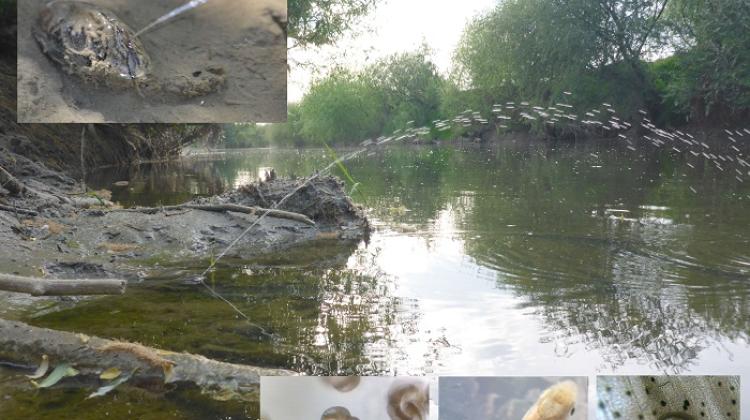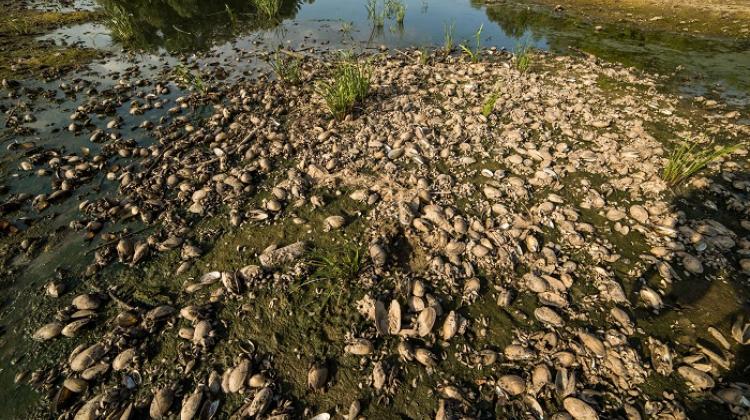Predatory naiad catches a ride inside fish body
 Credit: www.iop.krakow.pl
Credit: www.iop.krakow.pl
A snapping shell, huge teeth and a long sticky thread help the predatory larvae of the thick shelled river mussel to lodge in the fish's gills and swim long distances. Polish researchers have solved the mystery of the strange jets of water that the female uses to lure fish - just like fly fishermen.
Scientists from the Institute of Nature Conservation of the Polish Academy of Sciences in Kraków described in the journal Ecology (https://doi.org/10.1002/ecy.4026) how mussels manipulate fish to send their young into the world. It turns out that river mussels burrow into the shore, from where they shoots mature larvae with jets of water.
The jet attracts fish, which swim up hoping that an insect has fallen into the water. When they try to eat the larvae connected by sticky threads, the larvae bite their teeth into their skin, the epithelium lining the mouth or gills.
Now they have caught a ride and can set off on a many kilometres long journey. During this time, the mussels mature, and the fish covers them with its own body and feeds them. Scientists describe the mechanism of 'catching' fish by mussels on the website of the Institute of Nature Conservation of the Polish Academy of Sciences in Kraków.
MYSTERIOUS JETS BY THE SHORE
Scientists explain the genesis of their research. In May and June, a person walking along the banks of natural Carpathian rivers can observe a strange phenomenon: streams of water gush from under the shore. A narrow jet of water, like from a syringe, flows in a tight stream towards the middle of the river, reaching a distance of about one meter. This phenomenon does not occur everywhere, only in places where a clay or muddy shore is adjacent to calm water.
An attentive observer will notice a large, half-surfaced freshwater mussel that tenses up every now and then, rising a little higher, and then a trickle of water gushes out of its outlet siphon under high pressure. Why is it doing this? There was a number of hypotheses and this phenomenon was finally explained by an international team in an expedition organized by scientists from the Institute of Nature Conservation of the Polish Academy of Sciences in Kraków.
Dr. Tadeusz Zając from the Institute of Nature Conservation PAS said: “We were planning to do this research, but our colleagues from Portugal and Cambridge were so fascinated by this phenomenon that we organized a joint event.”
The research area was the Biała Tarnowska River in the Carpathians, where the population of mussels is still a very large, and the results were published in an article in the journalEcology.
YOUNG NAIAD: A SNAPING SHELL, TEETH, AND A LONG STICKY THREAD
The female mussel lays tens of thousands of eggs in special sacs made of transformed gills. It takes care of them, protecting them in its shell in well-oxygenated conditions, where after a few weeks of development, a larva (called glochidium) hatches from the egg.
It resembles a mussel, but its size does not exceed a fraction of a millimetre. Each larva has huge teeth on the outer edge of the shell and a long, sticky thread that extends out of the shell when the larva is released into the water.
Scientists previously considered these organisms to be parasites of the gills, but later research showed that after getting out of the gills into the water, the larva sticks with its sticky thread to everything the thread touches. The larva is constantly snapping the shell with teeth, and when the sensory hairs inside are irritated, it closes, sinking its teeth in permanently. As it turned out, a larva the size of a fraction of a millimetre cannot transform into an adult, seven-centimetre mussel, unless it goes through a period of parasitism on an adult fish of certain species.
Adult females of most of the 16 species of this group known in Europe release their young into the water, where they unravel their threads, quite accidentally catching fish. The probability of infecting the fish is therefore incredibly low, near zero. If a few of the tens of thousands of larvae released by the female transform during the season, it is already a success.
A FISH ATTRACTED TO WATER MINED WITH LARVAE
The team's research has shown that the mussel attracts fish much like fly fishermen. On the day when the larvae reach maturity, the female climbs onto the shore and digs itself into it above the waterline so that its lower siphon is submerged in the water and the upper siphon protrudes above the surface. From time to time, the female closes the shell and siphons to create pressure inside, which then flushes the larvae from the gills and ejects them outside the shell, carried away by a jet of water gushing through the reopened upper siphon.
Each jet of water contains a bundle of mussel larvae, held together by long, sticky threads. When it falls on the surface of the water, it attracts fish, which immediately swim to this place in the hope of finding a high-calorie insect. They swim in stagnant water 'mined' with sticky threads, and when they try to eat a cluster of larvae, those bite their teeth into the fish skin, the epithelium lining the mouth or gills. Then, in about two weeks, the larvae transform into the next stage of a miniature, but independent mussel (called pediveliger), which, moving with the help of an extendable leg, buries itself in the mud, where, after a few more weeks, it starts filtering and leading an independent mussel life.
CLEVER MUSSELS LOSE TO POLLUTANTS
The scientists from Kraków explain that infecting fish has one more aspect - mussels are sedentary animals, but they live in flowing waters, so any larva released by mussels would be flushed down the river. These mussels live mainly in fast-flowing rivers, where their clusters are often destroyed during floods, while floods always create completely new places that for a sedentary mussel are difficult to inhabit.
Thus, the only method of free colonization of the river environment is the 'clever' use of fish as 'taxis', involuntarily planted with mussel larvae. The fish can carry the larvae over many kilometres, covering and feeding them with its own body, because the larvae grow on the epithelial cells of the host and drink whatever is inside the cyst produced by the fish.
Unfortunately, this fascinating species is no longer the most numerous mussel in Polish waters, on the contrary, it is highly threatened by pollution and hydrotechology. It is not without significance that its host fish are also disappearing.
The river mussel is protected by Polish law and the EU Directive, it is also listed on the IUCN Red List, but the whole group is one of the most endangered species in the world. Centres for the artificial breeding of freshwater mussels are currently being established in order to restore their populations; in Poland, such a mussel breeding centre is run in the Świętokrzyskie province by the Institute of Nature Conservation of the Polish Academy of Sciences, in cooperation with the Świętokrzyskie Board and the Nadnidziańskie Landscape Parks.
Co-authors of the paper published in Ecology are: David C. Aldridge, Joshua I. Brian, Adam Ćmiel, Anna Lipińska, Manuel Lopes-Lima, Ronaldo Sousa, Amilcar Teixeira, Katarzyna Zając and Tadeusz Zając.
PAP - Science in Poland, Karolina Duszczyk
kol/ bar/ kap/
tr. RL
Przed dodaniem komentarza prosimy o zapoznanie z Regulaminem forum serwisu Nauka w Polsce.

















